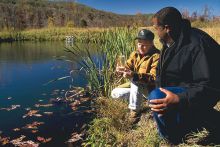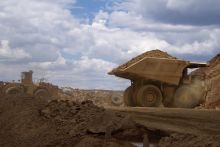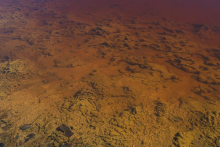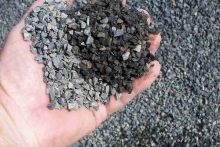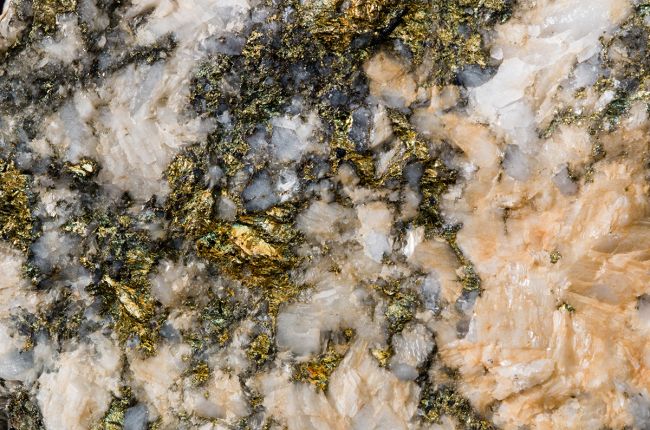
Biomining is mineral processing with microbes.
Biomining is the process of using microorganisms (microbes) to extract metals of economic interest from rock ores or mine waste. Biomining techniques may also be used to clean up sites that have been polluted with metals.
Valuable metals are commonly bound up in solid minerals. Some microbes can oxidize those metals, allowing them to dissolve in water. This is the basic process behind most biomining, which is used for metals that can be more easily recovered when dissolved than from the solid rocks. A different biomining technique, for metals which are not dissolved by the microbes, uses microbes to break down the surrounding minerals, making it easier to recover the metal of interest directly from the remaining rock.
What metals are currently biomined?
Most current biomining operations target valuable metals like copper, uranium, nickel, and gold that are commonly found in sulfidic (sulfur-bearing) minerals. Microbes are especially good at oxidizing sulfidic minerals, converting metals like iron and copper into forms that can dissolve more easily. Other metals, like gold, are not directly dissolved by this microbial process, but are made more accessible to traditional mining techniques because the minerals surrounding these metals are dissolved and removed by microbial processes. When the metal of interest is directly dissolved, the biomining process is called “bioleaching,” and when the metal of interest is made more accessible or “enriched” in the material left behind, it is called “biooxidation.” Both processes involve microbial reactions that can happen anywhere the microbes, rocks, and necessary nutrients, like oxygen, occur together.
What processes are used to biomine?
The most common processes used in biomining are:[1]
- Heap leaching: freshly mined material is moved directly into heaps that are then bioleached.
- Dump leaching: low-value ore or waste rock is placed in a sealed pit and then bioleached to remove more of the valuable metals from the waste pile.
- Agitated leaching: crushed rocks are placed into a large vat that is shaken to distribute the microbes and material evenly and speed up the bioleaching process.
Leaching times vary from days to months, making this process slower than conventional mineral extraction techniques.[1] Dump and heap leaching are the oldest and most established biomining techniques, but the use of agitated leaching is becoming more common for minerals that are resistant to leaching, including some copper sulfides like chalcopyrite.
What are the environmental risks of biomining?
Most current biomining operations use naturally occurring microbial communities. Because these types of organisms are already common in the environment, the risks from the release of the microbes themselves into the local environment are considered to be relatively small. The greatest environmental risks are related to leakage and treatment of the acidic, metal-rich solution created by the microbes, which is similar to the acid mine drainage from some abandoned mines. This risk can be managed by ensuring that biomining is conducted under controlled conditions with proper sealing and waste management protocols.
How common is biomining?
Biomining is currently a small part of the overall mining industry. It is used most frequently when the percentage of the desired metal in a rock is small, or to extract remaining metals from waste rock after conventional mining. In Chile, which currently produces one-third of the world’s copper, many of the most copper-rich ores have already been mined. As a result, biomining is increasingly being used to mine deposits with low percentages of copper,[2] and worldwide, 10-15% of copper is extracted using bioleaching.[2,3] Biomining is also important in the gold industry, where roughly 5% of global gold is produced using biooxidation.[2,3] As metal-rich ores are depleted worldwide, and with advances in microbial research and engineering, biomining may become more common in the future.
Other uses of biomining
- New biomining techniques that do not involve oxidation are being tested, which would enable large-scale biomining for different types of minerals and metals.
- Some researchers and companies are testing the use of biomining for recycling, to recover valuable elements from wastewater and electronic waste.
- Several smaller operations recover metals from existing acid mine drainage.[4] These operations recover economically valuable metals that would otherwise cause pollution.
- In Europe, the BIOMOre project is studying the feasibility of biomining deep underground to avoid having to excavate the rocks themselves.[5]
Learn More
- Microbial Life Education Resources (Website) Science Education Resources Center (SERC)
Website with educational resources about microbes in the environment, including a section on microbial mining.
- Urban Biomining (Video) NASA 360
In this video, NASA scientist Lynn Rothschild discusses a NASA Innovative Advanced Concept study to use biomining for metal recycling on earth and in space.
References
1 Biomining: biotechnologies for extracting and recovering metals from ores and waste materials Current Opinion in Biotechnology
2 Copper bioleaching in Chile Minerals
3 Progress in bioleaching: applications of microbial processes by the minerals industries Applied Microbiology and Biotechnology
4 Producing Copper Nature’s Way: Bioleaching Innovations
5 BIOMOre: Research on Future Mining BIOMOre 2017


